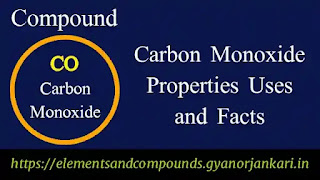Properties Uses and Facts about Carbon Monoxide
What is Carbon Monoxide
Carbon monoxide is a chemical compound with the chemical formula CO, it is
a colourless, odorless and tasteless gas. The molecule of carbon monoxide
contains one atom of carbon and one atom of oxygen. It is the simplest
molecule of the oxocarbon family. It is a toxic gas, being in an atmosphere
containing carbon monoxide for a long time can be fatal. This gas is a major
component of many processes in chemistry. Thermal combustion is the most
common source of carbon monoxide, but there are also many environmental and
biological sources that emit significant amounts of carbon monoxide.
 |
| Carbon Monoxide Properties Uses and Facts |
Properties of Carbon Monoxide
- Carbon monoxide is a colourless, odourless, tasteless and toxic gas.
- Carbon monoxide has a density of 1.14 kg per cubic meter, so it is a slightly lighter gas than normal air.
- The melting point of carbon monoxide is -205 °C.
- The boiling point of carbon monoxide is -191.5 °C.
- Carbon monoxide is a flammable gas, and its flash point is -191 °C.
- This gas spontaneously ignites at a temperature of 605°C.
- A bright blue flame is formed on burning carbon monoxide gas.
- This gas is sparingly soluble in water, and is soluble in chloroform, acetic acid, ethyl acetate, ethanol, ammonium hydroxide, and benzene.
Uses of Carbon Monoxide
- It is used in the refining of nickel metal.
- It is used in the production of detergents.
- It is used in the production of methanol.
- It is used as a reducing agent. For example, when carbon monoxide is passed over hot iron oxide, it converts the iron oxide into iron metal, and carbon monoxide gas gets converted into carbon dioxide gas.
- It is used to make high power infrared lasers.
- It is used to remove rust from the surface of metals.
- It is used to increase acidity in foods and beverages.
- It is used in packaging of fresh meat like fish, beef etc.
- It is used in the production of phosgene.
Facts about Carbon Monoxide
- Carbon monoxide is an odorless gas, when we breathe in the atmosphere of carbon monoxide, we do not even feel it. Carbon monoxide is extremely harmful when inhaled, as it displaces oxygen in the blood, depriving the heart, brain and other vital organs of oxygen. Within minutes, large amounts of carbon monoxide begin to take effect without warning, causing a person to lose consciousness and suffocate, which can result in death if inhaled for a long time.
- Carbon monoxide is produced when any fuel is burnt. Therefore, any work that requires the burning of fuel should be done in an open area with adequate air ventilation. Burning of fuel in an enclosed space depletes oxygen and increases the level of carbon monoxide, which is extremely injurious to health.
- Gas geysers are used to heat water for bathing in winter, in gas geysers gas is burnt to heat water, which requires oxygen. When a gas geyser is used in a closed space or bathroom, then all the oxygen present in that bathroom is used to burn the gas, due to which there is a lack of oxygen in the bathroom and the level of carbon monoxide starts increasing. Carbon monoxide is an odorless gas, we do not detect it while breathing. A person becomes unconscious by breathing in the atmosphere of carbon monoxide and breathing in this environment for a longer time also leads to death. Many such accidents related to geysers have happened in the past, so gas geysers should always be used at a place where it can get adequate ventilation of the air.
- Breathing in an atmosphere of carbon monoxide causes initial symptoms such as headache, deterioration of vision, shortness of breath and hallucinations, prolonged exposure to that atmosphere can cause symptoms such as low blood pressure, chest pain and fainting. Prolonged exposure to such an environment can result in coma and death. If a person experiences carbon monoxide poisoning, they should immediately move to fresh air, carbon monoxide poisoning tends to heal faster once they step into the fresh air.
Detailed Information on Some other Gases
- Hydrogen Properties Uses and Other Details
- Phosphine (PH3) Properties Uses and other information
- Oxygen Gas | Properties | Uses | Facts
- Helium Gas | Properties | Uses | Facts
- Neon Gas | Properties | Uses | Facts
- Argon Gas | Properties | Uses | Facts
- Xenon Gas | Properties | Uses | Facts
- Krypton Gas | Properties | Uses | Facts
- Radon Gas | Properties | Uses | Facts
- Fluorine Gas | Properties | Uses | and Facts
- Chlorine Gas | Properties | Uses | and Facts
- Nitrogen | Properties | Uses | and Facts
- Methane Gas | Properties | Uses | Facts
- Sulfur dioxide SO2 | Properties | Uses | and Facts






No comments:
Post a Comment